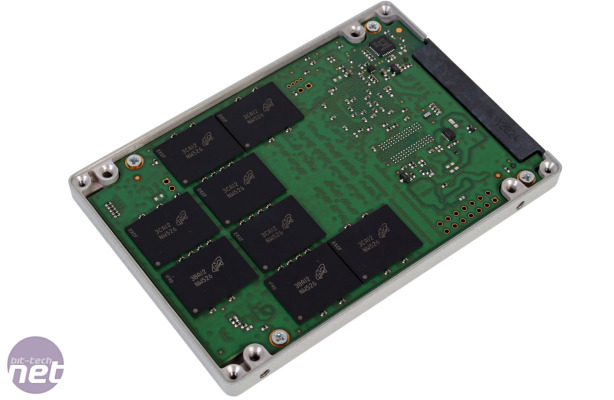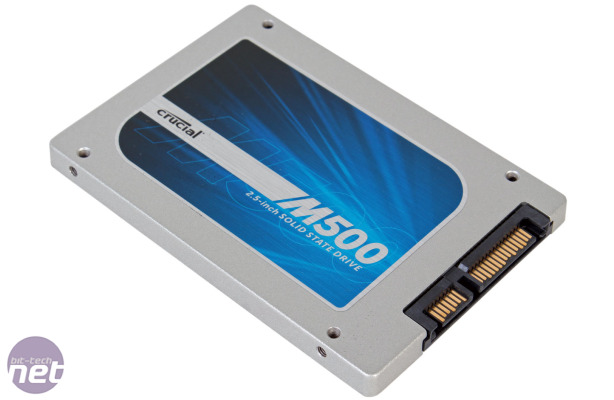Crucial M500 SSD 480GB Review
September 16, 2013 | 08:44

Performance Analysis
The M500's sequential read performance is on par with the claimed 500MB/s speed. However, Samsung's SSD 840 Evo maintains approximately a 40MB/s advantage in this field, while even older generation drives like the SSD 840 and Crucial's own M4 are able to keep ahead of it. Pleasingly, the results in these tests and in every other were consistent after we had filled the drive a few times and ran the TRIM command.Sequential write speeds are actually a little higher than the 400MB/s specs, with CrystalDiskMark showing transfer speeds of 424MB/s. This is a huge improvement over the previous generation drive, the M4, as well as a big leap ahead of Samsung's TLC-based SSD 840. The 840 Evo, however, has approximately a 100MB/s advantage here. This is a pretty big blow for the M500, but bear in mind that while the M500's speeds will stay fairly consistent, any write command that exceeds the 840 Evo's simulated-SLC TurboWrite buffer (3GB, 3GB, 6GB, 9GB and 12GB for the full range of 120GB to 1TB drives) will instantly fall to speeds closer to those of the original 840.
While there's certainly improvements over the M4 in single queue depth random read speeds, the M500 is only able to match the speeds here set by the SSD 840 of around 28MB/s. As such, it's given a bit of a thrashing by the similar capacity 840 Evo, which peaks out at close to 45MB/s in CDM. Random write performance, however, is a wholly different tale, as the M500 achieves the fastest speeds we've seen from an SSD (barring the 840 Evo in its RAM caching Rapid Mode). This is obviously an excellent result, and a great coming together of the hardware inside the M500.
At higher queue depths, the M500 copes admirably for a mainstream part, putting a huge distance between itself and the M4 and only falling shy a little of the pace set by costlier performance drives. The Evo does regain a slight advantage here, but these queue depths are unrealistic for most users, and it's still good to see that Micron's controller doesn't crumble under the increased workload.
The PCMark 7 secondary storage test shows the M500 struggle a little in the starting applications test, with its result of 52MB/s placing it near the bottom of the chart. Both the Samsung SSD 840 and the 840 Evo are about 15 percent faster here, and they maintain a lead in the gaming test too, albeit a much less significant one. Finally, our BootRacer test reveals a Windows 7 start up time that's certainly not slow, but is still a little behind other mainstream offerings like the Evo drives and SanDisk's Ultra Plus.
Conclusion
SSD prices seem to fluctuate more than any other component, but at the time of writing at least both the Crucial M500 480GB and the Samsung SSD 840 Evo 500GB can be had for £270 on Amazon, and their prices tend to always be closely matched. Unfortunately for Crucial, Samsung's drive almost always has a performance advantage, both in real world and synthetic benchmarks. The Migration and Magician software, which offer a three step Windows migration process and a one click dramatic speed boost with Rapid Mode, means there's also something to be said for the Samsung drive's ease of use, a big plus in the mainstream market. The M500, on the other hand, offers just a basic spacer with the SSD and no software.We feel like there's still something to be said for the M500, however. It may not come with software or RAM caching trickery, but its feature set, which seems influenced by the enterprise side of things, is excellent. With protection against power loss, NAND redundancy and eDrive compatible hardware encryption, it has plenty to offer that competitors do not. It may also not be the quickest drive around, but it's still quick - and consistently so, so if such features are important to you, and particularly if you often find yourself writing particularly large chunks of data, it's a worthy competitor to Samsung.

-
Performance40 / 50
-
Features14 / 15
-
Value31 / 35


MSI MPG Velox 100R Chassis Review
October 14 2021 | 15:04










Want to comment? Please log in.